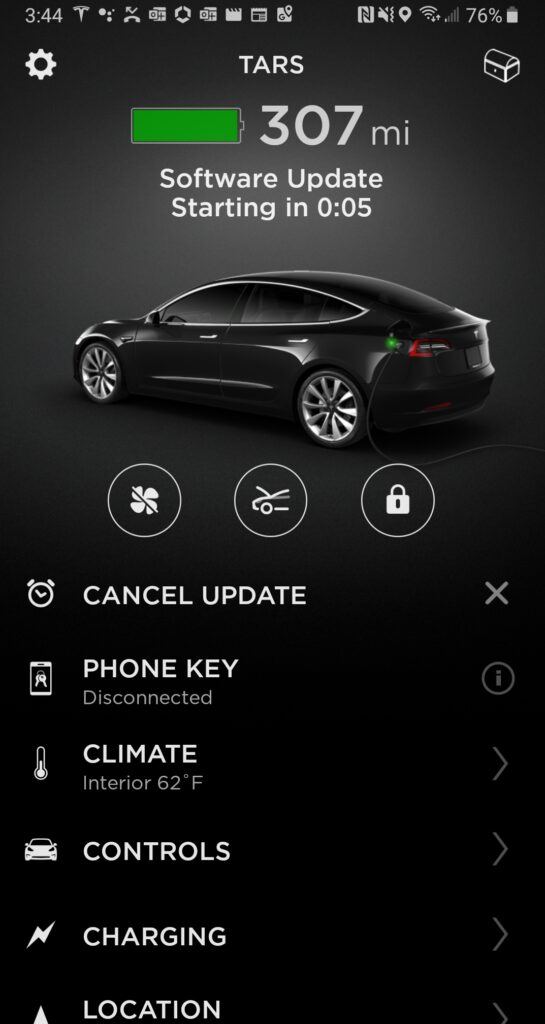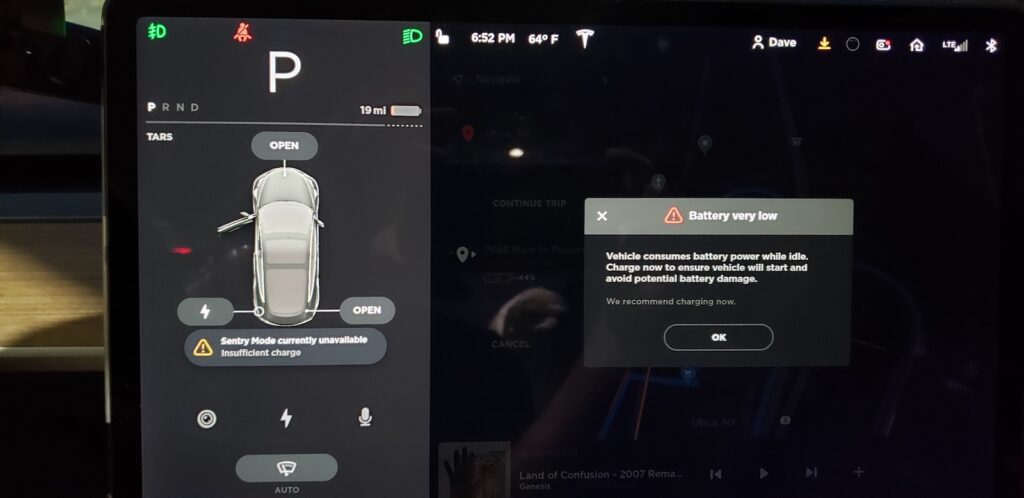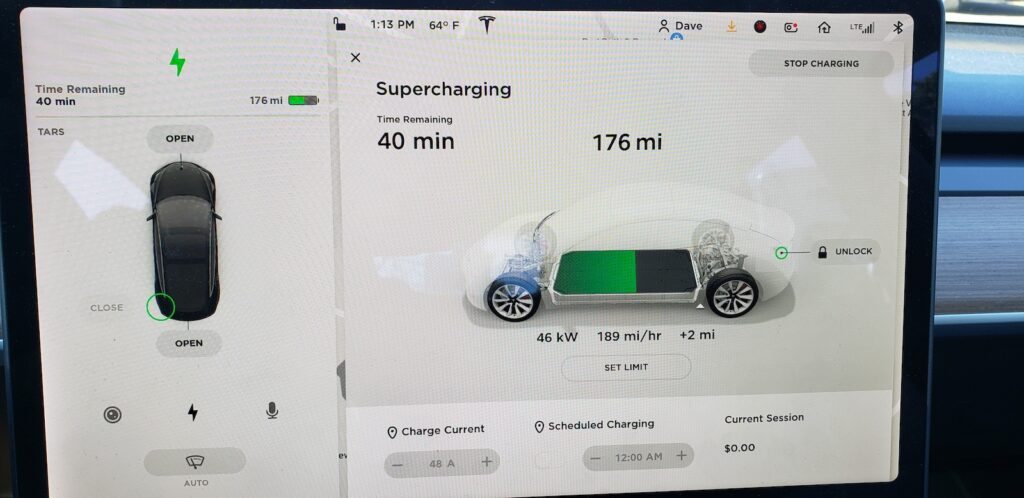This past weekend I finally got to let TARS, my Tesla Model 3 Performance, stretch its legs a big and go for some long distance driving. Over 3 days, we covered almost 700 miles, from Boston, MA to Rochester, NY.
This drive is almost entirely interstate, with the absolutely mind numbing stretch of the NY Thruway between Syracuse and Rochester coming to mind as the most tedious part of the trip. I was looking forward to using Autopilot for that bit in particular, and I wasn’t disappointed.
Preparation

My Model 3 is normally set to charge to 90%, which gets me about 270 miles of range. According to Tesla, this helps preserve the lifetime of the battery. But for short term trips, it’s okay to go into ‘trip mode’ – charge the battery to 100%. That brought my range up to about 307 miles. Golden!
The next step was to plan the trip a bit. With my battery topped up, the trip analyzer said that I could make it to the Utica, NY supercharger in one go. That’s about 270 miles, and I in theory would have 35 miles left when I get there. Now, I treat these estimators with a heavy dose of skepticism. There’s a lot of factors that impact battery consumption – a static analysis would have resulted in a lot of ‘Yeah, but what about…’ questions. However, this estimation was being done by the car, while I was driving it, with active traffic reports being reported in in realtime. It should be pretty accurate, we’ll see!
Departure
We rolled out around 2pm on Friday and immediately ran into unexpected traffic (later we learned from some friends that it wasn’t just us – all the routes headed west were problematic). TARS kept updating the route onto more and more secondary roads, to the point where I was expecting us to be routed through someone’s garage and down their garden paths. Hopefully I could avoid any empty swimming pools.
Finally, we got past the traffic and on the open road. The car settled into the traffic fine, and I was able to enable autopilot for a large part of the rest of the trip.
Autopilot
There’s an awful lot of jawing going on about the Tesla Autopilot. It’s not full self driving (FSD), no. It’s also not ‘just adaptive cruise control’ (as I’ve heard others yammer). It’s somewhere in between. On an open highway, without much traffic, it’s dreamy. Lane changes, slowing down / speeding up according to traffic changes, dealing with people merging in or passing, it works well. The car software is updated often – anywhere from once a week to every few weeks. And each time a new version comes down, the autopilot gets better, smoother, and less janky.
Here’s a good example. When I received my car in May, it was just after the ‘automatically change lanes’ function was enabled. And it was sketchy AF. Yes, it would signal, change lanes, and continue. But the signal ranges were all goofy, and if there was someone anywhere near your blindspot, the car would sort of ‘stall’ – leaving the blinker on, waiting for the other car to move. If they backed off to let you in (like all nice New England drivers do, right?), the autopilot wouldn’t pick up on the situation change fast enough, so would just sit there with the blinker on. Naturally, the other driver would speed up thinking I wasn’t changing lanes, and then Autopilot would decide there was a threat, and ‘phantom brake’ or jog back into lane. it was unnerving.
With the current version (v32.12.1 – one patch level beyond the v10 release), this process is FAR smoother. I was comfortable letting the car decide when to change lanes to get around slower traffic, or move over to let other cars by.
Interstate changes and ramps were still a little off. When the car does not have clear lines on the road on ramps (which tend to be wider than normal highway lanes), it tends to disconcertingly head toward the outside of the ramp until it’s close to a line, then sort of jog back. It’s jarring and uncomfortable, but it will do it. I let TARS make 2-3 highway changes for me, keeping my hands and brake-foot ready for a sudden takeover.
First Recharging Stop
Eventually we made it to Utica, and pulled into the charging station. At this point, the display was showing we had about 20 miles of battery range left. I had been watching the numbers the entire drive, and even with the traffic, rain, etc, the numbers really didn’t change much. The computer had the advantage of having access to traffic, weather, temperature, and route information, as well as how my batteries were behaving. It didn’t get it wrong.

We jacked into the supercharger and got the message “20 minutes until you can continue your trip” – Huh! 4+ hours of driving, and a recharge in 20 minutes? I’m good with that. Lets grab dinner.
So we walked to the local food joint and had a quick meal while the car recharged.
Getting back in, we were at something like 240 miles of range, plenty of electrons to get us the last 2 hours to Rochester.
We ended up going to our friends house first, then to the hotel, which left us with about 90 miles of range. Plenty for the next day, but we should top it up at some point.
On Saturday, we topped up the car with a very fast stop at the local supercharger (20m on the charger), which got us back up to about 200 miles. This is where I start having some questions.

It looks like not all superchargers are the same. Some have very good high speed charging (500+ miles per hour charging speed), others are lower. It’s not because there’s more cars at the charging station or anything, the level of power coming from each station just seems to vary. This is disconcerting, because when you’re trip planning, some stations may be able to charge your car up to full trip-level charge in 40 minutes, others may take an hour and change. Now, the charging ‘curve’ for a Tesla isn’t flat. To go from 0-75% charge can take as long as it takes to go from 75% to 100%. If you’re doing long distance driving, the time it takes to top up gets important. The station near the hotel was not charging as fast as the one in Utica. That was concerning, because we should be able to fill up before we drove home on Sunday. Timing would be important.
Departure
At the end of weekend, we did the happy party trick of showing off Enhanced Summon in a crowded private parking lot (there were half a dozen cars in our friends driveway, and rock walls all around. I walked a hundred feet away and did a “HOLD MY BEER” by summoning TARS to me. It did it BEAUTIFULLY. The summon feature has improved greatly in two or three weeks it’s been out. Very smooth, and doing exactly what a human would have done to back up, move the car forward and back 2-3 times to line it up with the exit, then roll over to where I stood.
It’s a great trick to impress your friends with. I asked our host “So, getting a Tesla now?” and he, a normally very conservative skeptical person, answered “I hadn’t thought about it before, but now I’m seriously considering it. I’m very impressed.”
Victory!
We headed out to the charging station I had used on Saturday, and had the same rate problem I saw before. So it wasn’t load or anything, it was just that this station sucked. We went for a walk in the local mall, and decided to head out. The mapping system set our next recharge in Lee, MA, about 270 miles away. We should arrive with 20-30 miles of charge left. So off we went.
The drive back was uneventful, with autopilot doing it’s thing for most of the drive. Oddly, my biggest issue was I rest my hand on the steering wheel giving it a little ‘tension’ to let the car know I’m there. After 20 minutes of leaving my hand in one spot, it would get tired and sweaty, and I had to switch hands. Talk about first world problems!

We got to Lee and plugged in, and YAY! Plenty of high speed charging! What a relief. We were able to top up the battery enough to get home in under 15 minutes, and we got home to a dog that was extremely happy to see us after such a long time away (Yes, we had people taking care of her, don’t be like that. But she did miss us).
Conclusions
All in all, the road trip was everything I expected it to be. Smooth, fast, comfortable, and best of all, 100% electric. Assuming our chargers were getting elecricity from standard sources, we produced 1/3rd as much carbon as we would have in a normal gas car. I personally buy my electricity from a wind farm, so at least 1/3 of the trip was from renewables, so that reduced our footprint even further.
Someone asked me from a cost perspective, was it cheaper driving an all electric car? I found an article that summed it up like this:
The long-range version of the Model 3 has a 75 kWh battery pack with a 310 mile range. If we still assume the average national electric pricing of 13 cents per kWh and a charging efficiency of 85%, then a full charge will cost $11.47. This is $3.70 per 100 miles of mixed city and freeway driving, or 3.7 cents per mile. This is almost 80% less than the cost per mile to drive the most popular gas-powered cars, which is approximately 20 cents per mile.
This fits my back of the envelope fiddling. I looked at my bill, and the entire charging costs from Sunday’s drive (about 370 miles) was $11.47. So not only was it not putting out any CO2, it was far far less expensive to operate than a traditional car.
I can easily see a future where more and more of these trips are automated, and my input into operating the car will be needed less and less. We’re not there yet, and we won’t be for I’m guessing another 3-5 years. But the progress is absolutely there, and I welcome it.